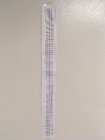X-Caveman
Gold $$ Contributor
I've been kicking around some ideas on a good way to share info on scope checkers. It looks like we may end up hosting a series of blog entries, photos and videos on our website. There will be too much bandwidth to do it all here, and I'm sure as hell not going to post YouTube videos.
It will take some time to accumulate and organize the info in a presentable fashion - especially during hunting season, with the holidays approaching and the hit or miss winter weather. We'll be bootstrapping it with my 10yr old son doing the filming & production, but what the heck, I think it we'll have fun and should be informative. As things develop I will update this post with links to articles.
As the first functional entry, I offer the attached two targets. In all cases, in order for the units of measure to be accurate, you must print them 1:1, or "Actual Size" in Adobe (on 11x17 paper). Don't just trust that it worked, either. I have provided measurements in inches that you'll need to confirm with a tape measure, rule, or calipers (if you're really nutty). You also need to use them at the yardages specified. The 50yd Elevation Tracking/ Tracking target must be at 50 yards. The box test has units for either 50 or 100 yards. You'll also have to do some cutting and taping on the travel target (photo). In both cases, use a plumb bob (weighted string) &/or a level to make sure the targets are hung as straight as reasonably possible.
Many of you will immediately realize how to use these, others likely will not. That's what our blog will be for (along with lots of other stuff). You need a rifle-mounted or bench-mounted (very rigidly) dual parallel scope mount (checker) to use these targets properly. The best way is on a bench rest gun, riding in your front rest and rear bag. Something that you can point VERY precisely. If it were move while cranking knobs, just re-point the reference scope back to the original POA. In NEITHER case do you need a frozen scope, or even live fire. In fact, a frozen scope would not work well at all.
More later. But for the time being, I hope you find these at least mildly useful...
It will take some time to accumulate and organize the info in a presentable fashion - especially during hunting season, with the holidays approaching and the hit or miss winter weather. We'll be bootstrapping it with my 10yr old son doing the filming & production, but what the heck, I think it we'll have fun and should be informative. As things develop I will update this post with links to articles.
As the first functional entry, I offer the attached two targets. In all cases, in order for the units of measure to be accurate, you must print them 1:1, or "Actual Size" in Adobe (on 11x17 paper). Don't just trust that it worked, either. I have provided measurements in inches that you'll need to confirm with a tape measure, rule, or calipers (if you're really nutty). You also need to use them at the yardages specified. The 50yd Elevation Tracking/ Tracking target must be at 50 yards. The box test has units for either 50 or 100 yards. You'll also have to do some cutting and taping on the travel target (photo). In both cases, use a plumb bob (weighted string) &/or a level to make sure the targets are hung as straight as reasonably possible.
Many of you will immediately realize how to use these, others likely will not. That's what our blog will be for (along with lots of other stuff). You need a rifle-mounted or bench-mounted (very rigidly) dual parallel scope mount (checker) to use these targets properly. The best way is on a bench rest gun, riding in your front rest and rear bag. Something that you can point VERY precisely. If it were move while cranking knobs, just re-point the reference scope back to the original POA. In NEITHER case do you need a frozen scope, or even live fire. In fact, a frozen scope would not work well at all.
More later. But for the time being, I hope you find these at least mildly useful...











